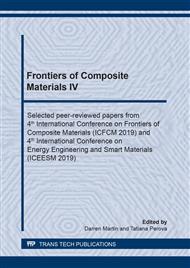[1]
P.N. Hiremath and S.C. Yaragal: Influence of mixing method, speed and duration on the fresh and hardened properties of Reactive Powder Concrete. Construction and Building Materials Vol. 141 (2017), p.271–288.
DOI: 10.1016/j.conbuildmat.2017.03.009
Google Scholar
[2]
P.-K. Chang and Y.-N. Peng: Influence of mixing techniques on properties of high-performance concrete. Cement and Concrete Research Vol. 31 (2001), p.87–95.
DOI: 10.1016/s0008-8846(00)00439-7
Google Scholar
[3]
R. Chylík and K. Šeps: Influence of cement replacement by admixture on mechanical properties of concrete. In: Proceedings of the 12th International fib PhD Symposium in Civil Engineering. Praha: ČVUT v Praze, Fakulta stavební (2018) pp.1267-1274. fib PhD Symposia. vol. 12. ISBN 978-80-01-06401-6.
Google Scholar
[4]
P. Bílý and J. Fládr: Influence of mixing procedure on mechanical properties of high-performance concrete. In: Fibre Concrete 2017. Bristol: IOP Publishing Ltd (2017). IOP Conference Series: Materials Science and Engineering 246, paper no. 012012.
DOI: 10.1088/1757-899x/246/1/012012
Google Scholar
[5]
V. Nežerka, P. Bílý, J. Fládr and V. Hrbek: Impact of silica fume, fly ash, and metakaolin on the thickness and strength of the ITZ in concrete. Cement and Concrete Composites Vol. 103 (2019), pp.252-262.
DOI: 10.1016/j.cemconcomp.2019.05.012
Google Scholar
[6]
P. Bílý, J. Fládr, R. Chylík, L. Vráblík, and V. Hrbek: The Effect of Cement Replacement and Homogenization Procedure on High Performance Concrete. Magazine of Civil Engineering Vol. 86 (2019), pp.46-60.
DOI: 10.4028/www.scientific.net/ssp.292.102
Google Scholar
[7]
V. Hrbek, Z. Prošek, R. Chylik and L. Vrablik: The effect of micro-silica on the microscopic features of the uhpc composite and its inter-facial transition zone, Acta Polytechnica CTU Proceedings 15 (2018), p.31–35.
DOI: 10.14311/app.2018.15.0031
Google Scholar
[8]
W.C. Oliver and G.M. Pharr: An improved technique for determining hardness and elastic modulus using load and displacement sensing indentation experiments. Journal of materials research Vol. 7 (1992), pp.1564-1583.
DOI: 10.1557/jmr.1992.1564
Google Scholar
[9]
G. Constantinides, K.S.R. Chandran, F.-J. Ulm and K.J. van Vliet: Grid Indentation Analysis of Composite Microstructure and Mechanics: Principles and Validation, Journal of Material Science and Engineering A Vol. 430 (2006), p.189 – 202.
DOI: 10.1016/j.msea.2006.05.125
Google Scholar


